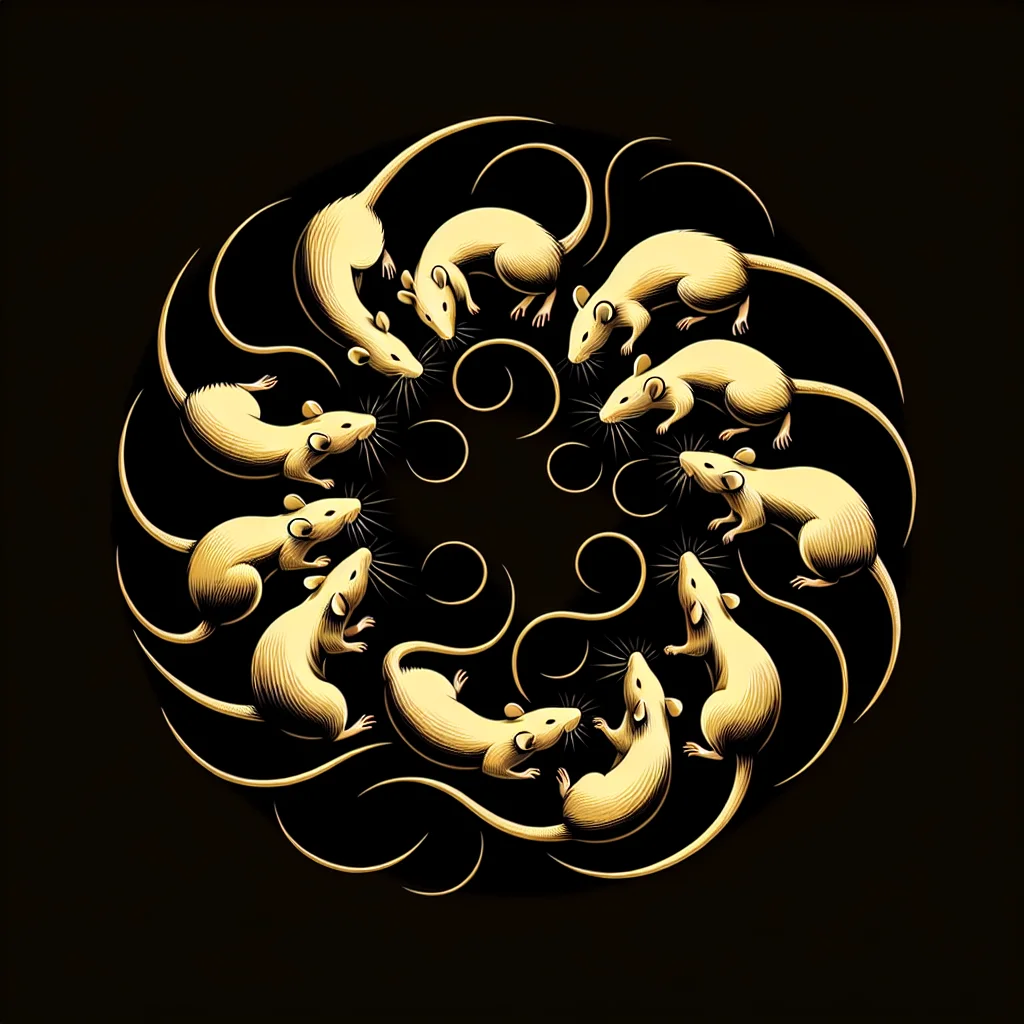2 minute read •
Comments
Silent Whispers: The Rise of Non-Verbal Communication in Ratopolis
June 14, 2025

Traditionally, Ratopolis rats communicated through squeaks and clicks, reminiscent of their foraging ancestors. However, today's innovative youth have birthed a nuanced form of non-verbal communication that includes expressive tail movements, often resembling complex dance routines. "Our tails are like paintbrushes, creating a masterpiece of meaning," said young artist Whistler Tailwind, demonstrating a sequence of flicks and curls that conveyed an entire narrative about his day.
Visual art has also emerged as a compelling medium for expression. Young rats cover the city's walls with murals and graffiti that depict a range of emotions, often serving as public messages of social or political significance. Meanwhile, an evolution in whistling techniques adds an auditory layer to this silent dialogue. These whistles, akin to musical passwords, are shared and interpreted within peer groups, establishing a secret yet inclusive language.
These non-verbal trends are not without their critics. Some older rats fear the erosion of traditional vocal communication. "I never thought I'd see the day when a tail wag could say more than a thousand squeaks," remarked Elder Whisk, a rat who sees value in history's tried-and-true methods. Despite this, many appreciate that such innovations highlight Ratopolis' dynamic cultural milieu.
The driving force behind this movement is a combination of technology and social media, which have allowed these trends to spread rapidly across generations. Social platforms buzz with video tutorials, guiding eager learners on the art of tail choreography and visual storytelling. "It's a whisker-twitching change, but it’s fascinating to see how the young ones express themselves," shared Ripley, a middle-aged rat who balances between tradition and innovation.
Expert opinions offer clarity on this cultural shift. Ratopolis sociologist, Dr. Squeakskin, notes, "Cultural evolution is natural; these non-verbal forms satisfy a need for creativity and individuality." In contrast, communication specialist Scriber Chewson expresses concern, "While novel, efficiency and clarity must be considered in such complex forms."
Historically, Ratopolis has witnessed significant communication shifts, from the adoption of written squeak to the introduction of rhythmic tapping. This evolution is not unique to Ratopolis alone; similar trends are emerging in other rodent cities, indicating a broader cultural phenomenon.
Looking to the future, many wonder how these trends will mold young rats' identities and societal roles. Will these new forms strengthen community bonds or isolate those clinging to vocal traditions? The future is uncertain, yet full of potential.
To those intrigued by Ratopolis' cultural evolution, consider this: how do these new methods of communication challenge or enrich your understanding of interaction and community in Ratopolis? Share your experiences and thoughts on embracing non-verbal communication as this dynamic city continues to evolve.
Looking for more in-depth news and exclusive content? Follow RAT TV for real-time updates, behind-the-scenes insights and the latest breaking news.
Visual art has also emerged as a compelling medium for expression. Young rats cover the city's walls with murals and graffiti that depict a range of emotions, often serving as public messages of social or political significance. Meanwhile, an evolution in whistling techniques adds an auditory layer to this silent dialogue. These whistles, akin to musical passwords, are shared and interpreted within peer groups, establishing a secret yet inclusive language.
These non-verbal trends are not without their critics. Some older rats fear the erosion of traditional vocal communication. "I never thought I'd see the day when a tail wag could say more than a thousand squeaks," remarked Elder Whisk, a rat who sees value in history's tried-and-true methods. Despite this, many appreciate that such innovations highlight Ratopolis' dynamic cultural milieu.
The driving force behind this movement is a combination of technology and social media, which have allowed these trends to spread rapidly across generations. Social platforms buzz with video tutorials, guiding eager learners on the art of tail choreography and visual storytelling. "It's a whisker-twitching change, but it’s fascinating to see how the young ones express themselves," shared Ripley, a middle-aged rat who balances between tradition and innovation.
Expert opinions offer clarity on this cultural shift. Ratopolis sociologist, Dr. Squeakskin, notes, "Cultural evolution is natural; these non-verbal forms satisfy a need for creativity and individuality." In contrast, communication specialist Scriber Chewson expresses concern, "While novel, efficiency and clarity must be considered in such complex forms."
Historically, Ratopolis has witnessed significant communication shifts, from the adoption of written squeak to the introduction of rhythmic tapping. This evolution is not unique to Ratopolis alone; similar trends are emerging in other rodent cities, indicating a broader cultural phenomenon.
Looking to the future, many wonder how these trends will mold young rats' identities and societal roles. Will these new forms strengthen community bonds or isolate those clinging to vocal traditions? The future is uncertain, yet full of potential.
To those intrigued by Ratopolis' cultural evolution, consider this: how do these new methods of communication challenge or enrich your understanding of interaction and community in Ratopolis? Share your experiences and thoughts on embracing non-verbal communication as this dynamic city continues to evolve.
Looking for more in-depth news and exclusive content? Follow RAT TV for real-time updates, behind-the-scenes insights and the latest breaking news.
Comments